Part 1 of 3: Misalignment of well objectives can complicate mitigation efforts and induce drilling hazards by limiting the ability to apply adequate hydraulic horsepower and to manage ECD.
David Pritchard, Successful Energy Practices International;
Patrick L. York, Scott Beattie and Don Hannegan, Weatherford
A drilling hazard is defined as any event off the critical path of drilling operations. Drilling hazard management focuses on wellbore stability and consequential hazards such as stuck pipe, fluids loss and equivalent circulating density (ECD) management. These events lead to non-productive drilling time in the least case, or catastrophic wellbore failure and loss of well control in the worst cases. Drilling hazard management requires understanding the uncertainty of the drilling margin: i.e., the safe applied ECD between the in situ pore pressure and/or stress equivalence and the fracture gradient as a result of the overburden.
Complex wells require multidisciplinary alignment to ensure and sustain performance. Aligning objectives is necessary to manage drilling hazards and associated mechanical risk critical to successful well execution. For example, geological uncertainties may require the ability to sidetrack a hole, yet a slim monobore solution is required to reduce drilling costs. These objectives usually conflict. It is important to understand disciplinary tradeoffs necessary to ensure drilling performance.
BASIC PRACTICES
Drilling hazard management (DHM) is the practice of managing the mechanical and efficiency risk of all drilling operations. (Within this article, we will deal only with DHM related to the risk of mechanical success, not risks associated with health, safety and the environment.) Managing these risks requires applying the best practices and mitigating technologies to successfully reduce the risk profile while improving the risk-adjusted cost of applying such mitigants successfully. Because hazards may include mechanical failure and human error in addition to geology, understanding the totality of drilling data is necessary to avoid inducing risks and to enable implementation of the most applicable mitigation measures.
One such example of DHM is simply to apply casing seat optimization to the maximum uncertainties of the drilling margin predictions. Predictions are always uncertain in the Earth model, but a well can be planned accordingly. Placing the seat at the maximum safe ECD point of the overburden fracture gradient ensures that the next hole section can be drilled to maximum depth and reduces the risk of issues such as ballooning in the next interval.
Another example involves the practice of planning an increase in mud weight at the base of an intermediate casing string before drilling out the shoe, especially in high-pressure/high- temperature operations, Fig. 1. Mud is usually weighted up because higher pressures are anticipated at greater depths, but this practice actually masks drilling conditions and negatively impacts drilling performance by increasing the confining stress of the mud weight column. This increase also creates unnecessary bit wear, resulting in premature trips with associated swab and surge that further impact wellbore stability. This practice is often defended as the safest approach, but in reality, a safer and more effective action would be to drill out the casing shoe with the same mud weight as was used to set the casing. This should be followed with a full leak-off test to obtain the safest ECD that the next hole section can tolerate, and then drilling ahead, raising mud weight as conditions dictate.
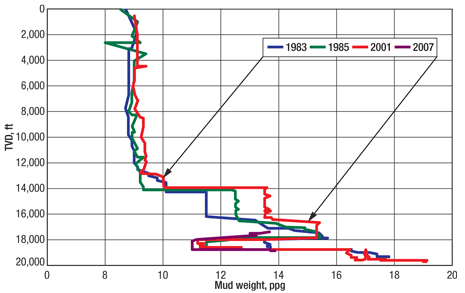 |
|
Fig. 1. Plotting mud weight versus vertical depth for four historical wells shows the evolution of mud weighting schemes from the 1980s to the present.
|
|
Another DHM example involves the uncertainty of pore pressure prediction. This uncertainty can lead drillers to exceed the drilling margin, or the safe envelope that can be drilled without danger of well control events, fluid losses, ballooning or fracturing of the well.
MULTIDISCIPLINARY PLANNING
Alignment of multidisciplinary objectives begins with a stage, gated well-planning process. The initial phase of the process is where the well is formulated and objectives are determined. Well objectives should be specific, measurable, achievable, relevant and timely.
Often the root cause of failure lies with objectives that are not initially aligned and understood by the disciplines or stakeholders. Well planners must guard against developing objectives that are not measurable, often conflict, and are not mutually achievable. The following objectives for a 12,000-ft TVD, 15,000-ft
MD directional well do not follow the well objective criteria listed above:
-
Right-size initial flow capabilities
-
Adequate hole size for evaluation, coring and completion
-
Completions free of formation damage
-
“Rigless” intervention capabilities
-
Minimal complexity
-
Directional well with a target on-bottom radius of 200 ft
-
Multiple targets
-
Design life
-
Good reservoir surveillance
-
Provision for a future sidetrack
-
Minimal number of casing strings
-
Small, low-cost monobore
-
Optimization of costs
-
Ability to frac stimulate the well
-
ESP artificial lift system.
For example, a small wellbore does not lend itself to fracture stimulation, has limited if any automated reservoir surveillance capabilities, and has limited sidetrack capabilities. Furthermore, the number of casings necessary to reach TD may prevent fracturing, high initial production rates and optimum installation of artificial lift systems. Maintaining a stable wellbore becomes especially challenging in directional sections with small hole size, which prevents the driller from applying enough horsepower to clean the hole. A small hole also complicates the ability to slide and achieve a smooth hole.
These design objectives induce wellbore stability issues and can impact the following issues:
-
Poor drilling performance as a result of reduced hydraulic pumping rates
-
Bit wear
-
Bottomhole steering difficulties, with excessive geosteering creating a tortuous well path
-
Inability to apply mud weight and effectively manage ECD in a slimhole environment.
The objectives listed above for this well result in many conflicts too difficult to manage, and thus cannot successfully be achieved in the same well. Misalignment of objectives can complicate mitigation efforts and often results in inducing drilling hazards by limiting the ability to apply adequate hydraulic horsepower and to manage ECD.
ALIGNING OBJECTIVES
Developing specific, measurable, achievable, relevant and timely objectives requires alignment from all stakeholder disciplines to determine which well design alternatives can best be accomplished. This multidisciplinary process requires understanding the tradeoffs, conflicts and compromises that are necessary between the “nice-to-haves,” “wants,” “needs” and “must haves.” Prioritizing objectives is the first step of a process to ensure initial disciplinary alignment.
Mapping a process to define ranges of measures for the objectives is the initial step in the process. This process is facilitated by capturing the ideas and committing to an auditable trail to ensure decision quality. Table 1 shows an objective alignment process where all the objectives meet the above criteria. Further qualification and quantification of the objectives are required, with the desired outcome being a prioritized list of objectives, after which the design process begins. DHM cannot occur until, at a minimum, objectives are prioritized, which leads to alternative well design considerations.
| TABLE 1. Typical project objectives and alignment process where conflicts are obvious |
 |
Failure to align objectives at the onset of well planning usually results in execution issues that are counterproductive to good performance and sustained learning. As an example, excessive geosteering can complicate the well path and actually create drilling hazards. Target boxes must be agreed on in the initial well planning stages and ensured during execution. A target box is a window around the entire directional section that limits or prescribes the limits of geosteering.
Although a large amount of geosteering may be agreed to by the stakeholders, there is a tradeoff in the risk of successful execution and, at the minimum, a negative impact on performance and well cost. Many things can change, such as the design of the bit and BHA. Multiple BHA and bit combinations are necessary to achieve this objective, requiring trips and inducing wellbore instability. All of these tradeoffs must be understood, quantified and risk-assessed to ensure multidisciplinary alignment and ultimate decision quality.
Examples such as this are also where total well engineering comes into play, as opposed to “widget” engineering—engineering a single product or service that does not consider the total well and its objectives. A bit designed for a build-and-hold angle does not work well when geosteering is required, nor does a tight or locked assembly to ensure holding angle, even with adjustable stabilization. These individual “widget” engineering designs are in conflict.
IMPACT OF UNCERTAINTIES
Uncertainties drive risk in everything. For example, the weather is an uncertainty. If the objective is to play golf, the more that is known about the forecast, the more narrow the range of uncertainty. The same philosophy applies to managing hazards and risk for any drilling and completion operation.
It is first necessary to understand how uncertainties impact risk. Uncertainties represent the unknowns in any drilling operation. An important aspect of uncertainties is to know whether they can be eliminated by way of decisions, or if at least their range can be narrowed. Eliminating or narrowing uncertainties is a multidisciplinary process. Decisions to eliminate uncertainties can include the rig selection process, posting a locked basis of design or deciding bottomhole targets and locking them into the well path.
The uncertainties that create the most problems and ancillary risks relate to the drilling margin. At the onset, establishing the safe drilling margin is an unknown prediction of pore pressure and fracture gradient. While predictions may come from many sources, they are never absolute. If the plan is to “nail” predictions to ensure good drilling performance, then success will not be sustained.
Risk occurs at the boundaries of the margin. For example, if the ECD is too high, fluid losses with varying consequences can occur. If the mud weight is too low, well control can be lost, also with varying consequences. In the planning phases, the key to narrowing the drilling margin’s range of uncertainty is to ensure that predictions are as reliable as possible and are adjusted with actual historical data, such as the mud weight that was applied in a well where fluid losses actually occurred. There are many other techniques that can be used, including improving predictions while drilling, such as D exponents (drilling exponents normally compiled in mud logs).
For the planning phase, once the predictions are as accurate as possible, alternative models can be developed that deal with the well objectives and uncertainties, and then manage the risk or hazard.
The first step toward managing hazards and risk, then, is to narrow the range of drilling uncertainties by developing a multidisciplinary uncertainty management plan. This plan should be developed in concert with specific, measurable, achievable, relevant and timely objectives in the initial concept phase of planning.
Consider the objectives listed in Table 2 for a hypothetical well, which conform to the requirement of being specific, measurable, achievable, relevant and timely. For these objectives, the key uncertainties are the cost of well to best accomplish them; the production rate range and the productivity index of the reservoir; drilling hazards such as fluids losses and stuck pipe; the height and thickness of the Target 1 reservoir; and the ability to geosteer within the tight target box. The last two uncertainties dictate alternative well models.
| TABLE 2. Developing an uncertainty management plan for the well models in Fig. 2 |
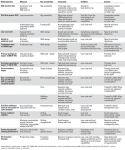 |
Table 2 illustrates how these uncertainties can impact the models (Fig. 2) and the resolutions required to determine the best-fit model for the final well design. The design of any well alternative begins with the recognition that the uncertainties of the drilling margin must be honored. Each casing seat must address the maximum force it can exert against the fracture gradient with safe tolerance at its vertical depth of deployment. The summation of the forces must balance; that is, the force of the applied ECD must equal the force exerted by the overburden fracture gradient of the earth in the wellbore.
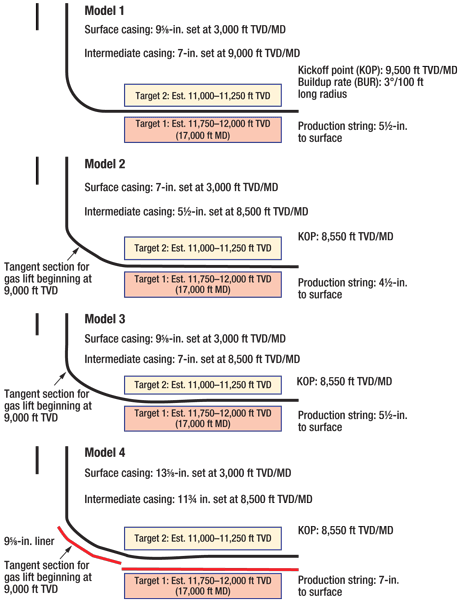 |
|
Fig. 2. Example well models for the objectives listed in Table 2.
|
|
Ignoring force balance when setting casing will result in a casing seat that is not at optimum depth and that, therefore, will not facilitate an optimum depth for drilling the next hole section. This deficit continues to compound with each successive casing seat. This is especially critical in narrow-margin drilling operations, especially in HPHT and deepwater environments. In the latter, the loss of overburden due to water depth plays a critical role in the top hole sections of the well.
Figure 3 depicts the optimum placement of casing seats that are normally inserted to the top of salt in a subsalt deepwater environment. Applying this methodology enables the optimum depth of each casing string, minimizing the number of casing strings required to complete the well. Managing the uncertainty of the drilling margin minimizes the occurrence of boundary risks and should be an initial principle of well planning and drilling hazard management.
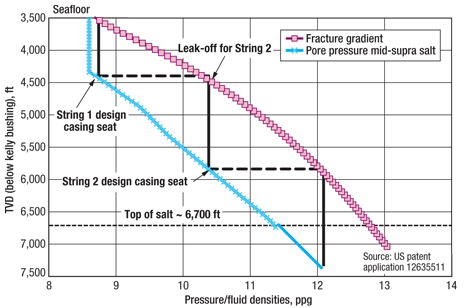 |
|
Fig. 3. Optimum casing seat placement in a subsalt deepwater environment.
|
|
Figure 4 shows the “stacking” effect created by the failure to optimize casing seats in the deepwater environment. It also indicates where the casing seats should be to optimize the uncertainties of the drilling margin.
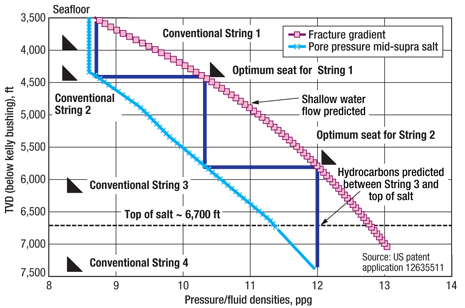 |
|
Fig. 4. Stacking” effect of non-optimized casing seat placement versus optimized placement in a subsalt deepwater environment.
|
|
In narrow-drilling-margin operations, the challenge is to optimize casing seats despite the fact that predictions of the drilling margin boundaries (fracture gradient on the high side, pore pressure on the low side) are never accurate, due to the complexity of the Earth model. Any particular casing string must be designed for its depth as if predictions are absolute, and casing specifications must have a design tolerance to drill and set deeper if conditions dictate. This is why actual drilling conditions must be monitored and why it is important to understand “well listening” as a necessary condition of casing seat optimization. Planned depth becomes the maximum predicted depth, plus more if hole conditions dictate. The contingency becomes a shallower setting depth. It is critical to ensure that the applied ECD plus safe tolerance is optimized for the given vertical depth, as dictated by actual drilling conditions.
A useful predictive tool is pressure while drilling (PWD), coupled with ahead-of-the-bit trend predictions such as D exponents and seismic data. However, even tools such as PWD and seismic data will not predict stress, and there is a distinct difference between stress and pore pressure. Stress is a vector and is imposed on the borehole by variables such as tectonics, faults or creeping salt diapers. These vectors can be quite different from pore pressure both in magnitude and in direction.
Pore pressure can be normal, yet stress can be much higher, but both require the same solution to stabilize the borehole: casing or mud weight. The uncertainty of this dynamic is critical in HPHT and deepwater environments. One reliable predictor of stress is D exponent trends, which represent the specific energy supplied to the drilling string and to the bit as well as the total of dynamic drilling conditions.
Casing optimization begins with the design and ends with understanding and properly interpreting actual drilling conditions to arrive at the correct setting depth. In terms of drilling hazard management, a mistake often made is to set the casing at a predetermined depth regardless of drilling conditions. Casing seat tolerance not high enough for the next hole section results in the premature setting of another string of casing or drilling liner. This makes all risks more difficult to manage and routinely results in expending unnecessary casings. The typical mitigant is then to set the liner or full string of casing and hope for better results, shifting the uncertainties and risk yet deeper. The shallower the depth at which the hazard can be managed, the better the risk profile, drilling performance and cost, and the safer the well.
NEXT INSTALLMENT
Part 2 of this series will address risk management and avoidance through proactive interpretation of real-time data, or “well listening.” Listening to the well while drilling is fundamental, and is defined simply as recognizing, integrating and correctly interpreting all drilling dynamics, weight on bit, rotational speed, ECD and shale shaker cuttings to assist in making the correct proactive decisions during operations. Whereas the advent of real-time data while drilling has in some cases become a “crutch” for drillers, resulting in misinterpretation of issues such as background gas, this technology can also assist in well listening and, thus, facilitate correct decision making and application of best practices. 
|
THE AUTHORS
|
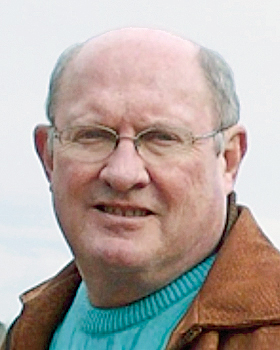 |
David Pritchard is a petroleum engineer with 40 years of industry experience, including management and supervision of worldwide drilling and production operations. He has consulted for an array of national and international independents, major companies and service providers. He has conducted technical audits and developed well plans leading to improved well execution for complex and HPHT wells. As owner of Pritchard Engineering and Operating, Mr. Pritchard developed, participated in and operated a number of oil and gas properties in the ArkLaTex region of the US, resulting in the successful discovery of over 500 Bcf of natural gas reserves. He holds a BS degree in petroleum engineering from the University of Tulsa.
|
| |
Pat York is the Director of Commercialization and Marketing for Weatherford’s Solid Expandables and Drilling Hazard Mitigation product/service lines. He has 38 years of oil and gas industry experience. Before joining Weatherford, Mr. York was Vice President of Commercialization and Marketing for Enventure Global Technology after tenures with Halliburton and Dresser Atlas. He earned a BS degree in electrical engineering at Northwestern State University in 1972 and pursued his MBA degree there in economics and management before launching his oilfield career.
|
| |
Scott Beattie has 22 years of oilfield service experience. After spells with Halliburton and Baker Oil Tools, he has spent the past 14 years with Weatherford in various technical and operational roles, primarily supporting drilling technologies. Mr. Beattie’s latest assignment is in Kuala Lumpur, Malaysia, as Global Business Unit Manager for Drilling with Casing. Mr. Beattie is regarded as a subject matter expert in casing-drilling applications and engineering and is a key member of Weatherford’s Drill Hazard Mitigation team. He is a co-inventor of several onshore and subsea casing-drilling technologies.
|
| |
Don Hannegan is the Drilling Hazard Mitigation Technology Development Manager for Weatherford. He received World Oil’s 2004 Innovative Thinker Award for his role in conceiving and developing specialized equipment and concepts applicable to managed pressure drilling of challenging and complex wells. He also was an SPE Distinguished Lecturer for 2006/2007, and is a charter member of the IADC UBO/MPD Committee and a founding officer of the Arkansas SPE section. He was recently appointed by the University of Texas Petroleum Engineering Extension Service (PETEX) to serve as lead author of a textbook to be titled Drilling Hazard Mitigation Tools & Technology.
|
|









